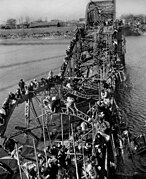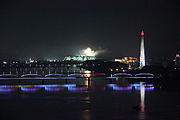Taedong Bridge
- Machine translation, like DeepL or Google Translate, is a useful starting point for translations, but translators must revise errors as necessary and confirm that the translation is accurate, rather than simply copy-pasting machine-translated text into the English Wikipedia.
- Do not translate text that appears unreliable or low-quality. If possible, verify the text with references provided in the foreign-language article.
- You must provide copyright attribution in the edit summary accompanying your translation by providing an interlanguage link to the source of your translation. A model attribution edit summary is
Content in this edit is translated from the existing German Wikipedia article at [[:de:Taedong-Brücke]]; see its history for attribution. - You may also add the template
{{Translated|de|Taedong-Brücke}}to the talk page. - For more guidance, see Wikipedia:Translation.

| Taedong Bridge | |
| Chosŏn'gŭl | 대동교 |
|---|---|
| Hancha | 大同橋 |
| Revised Romanization | Daedonggyo |
| McCune–Reischauer | Taedonggyo |
The Taedong Bridge (Korean: 대동교) is a bridge over the Taedong River in Pyongyang, North Korea.[1]
The bridge was built by the Japanese and completed in 1905. It is one of Pyongyang's two oldest east–west connections via the Taedong Gang, along with the Yanggak Bridge, built in the same year.
It was largely destroyed in the Korean War. When Chinese troops advanced near Pyongyang in the winter of 1950, thousands of civilians fled to the rubble of the bridge to cross the river in which several people were killed. The crossing of the ruined Taedong Bridge was part of the larger evacuation of Pyongyang during the Korean War.[2] The event was taken on December 5, 1950, by Associated Press photographer Max Desfor titled Flight of Refugees Across Wrecked Bridge in Korea, for which he won the Pulitzer Prize for Photography in 1951.
Gallery
-
 The bridge in the 1920s
The bridge in the 1920s -
 The Pulitzer Prize–winning photo Flight of Refugees Across Wrecked Bridge in Korea (1950)
The Pulitzer Prize–winning photo Flight of Refugees Across Wrecked Bridge in Korea (1950) -
 Under the bridge (1988)
Under the bridge (1988) -
 The bridge at night, along with Juche Tower to the right and fireworks for the Arirang Mass Games in background (2012)
The bridge at night, along with Juche Tower to the right and fireworks for the Arirang Mass Games in background (2012)
References
39°00′44″N 125°45′25″E / 39.0122°N 125.7570°E / 39.0122; 125.7570
- v
- t
- e
 | This article about a bridge in Asia is a stub. You can help Wikipedia by expanding it. |
- v
- t
- e














